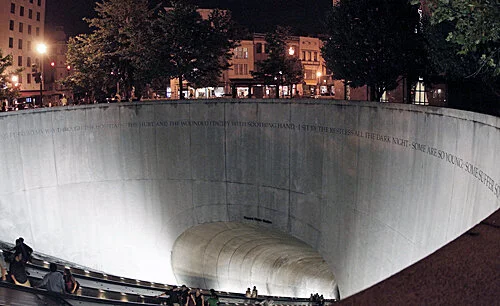Nurses on the road
My sister, Betty, is a retired nurse. She specialized in taking care of patients in the Intensive Care Unit, ICU. She handled heart monitoring machines, operated ventilators, and supervised intubations. She was a life saver. So, in recognition of all the nurses who are on the front lines during this war against Covid-19, I dedicate this On the Road issue to her and to her sisters’ heroism and their sacrifices.
In previous issues I have recognized some of the statues that honor the nurses, such as the one opposite the Wall in Washington D.C. and the one in Langston Park
There is a whole dedication to Clara Barton in the foyer of a rest stop on the New Jersey Turnpike
I later found out that she has a proper monument at the Antietam Battlefield
By chance I found this old Civil War Photo of Clara in a hospital field tent.
There is a plaque on the sidewalk of Wall Street that honors a French Nurse, Genevieve de Galard-Terraube who would not leave her patients even after the Vietnamese had captured the base at Dienbienphu.
There is another nurse who has a statue dedicated to her service in Vietnam at the Aultman School of Nursing in Canton, Ohio. Sharon Lane, a U.S. Army nurse, was the only American servicewoman killed by direct enemy fire during the Vietnam War.
There is another poignant statue at Duke University that highlights the importance of nurses during World War II. In February 1944 doctors and nurses of the Duke School of medicine affiliated with the 65th General Hospital were ordered to Botesdale, Suffolk in England. After the D-Day Invasion it received trains with up to 600 casualties each, transferred from evacuation and field hospitals on the continent. During the 22 months it was in service, the hospital served 17,250 bed patients.
While we’re in England, let’s see how the British Empire recognizes the contribution of its nurses. First in Vancouver, Canada, there is a building that has a statue of a nurse prominently displayed on its corner.
The story is that architects, John Young McCarter and George Colvil Nairne had both served overseas in WWI. McCarter had been seriously wounded and credited the nursing sisters with saying his life. When they had the opportunity, they paid tribute to the nurses with this statue.
Second, there is a statue on Winnipeg’s Memorial Boulevard that pays tribute to the women who served in Canada’s Armed Forces during World War I and II. During World War I nearly 3000 Canadian women were military nurses and during World War II some 45,000 women were clerks, cooks, heavy equipment drivers, telephone operators, parachute riggers and mechanics in Canada’s armed forces.
Third, the statue of Mary Seacole stands opposite the Houses of Parliament in the grounds of St Thomas' Hospital. Mary Seacole was a Jamaican-born nurse who cared for wounded British soldiers during the Crimean War in the 19th Century. Seacole funded her own trip to the Crimea where she established the British Hotel near Balaclava to provide a mess-table and comfortable quarters for sick and convalescent officers. She also visited the battlefield, sometimes under fire, to nurse the wounded, and became known as 'Mother Seacole'. Her reputation rivalled that of Florence Nightingale.
Fourth, being a British nurse was a dangerous assignment during wartime. In addition to avoiding contracting debilitating diseases, and dodging bullets and artillery shells, a nurse had to tread carefully when on captured soil. Edith Louisa Cavell, a British nurse, saved the lives of soldiers from both sides without discrimination and helped some 200 Allied soldiers escape from German-occupied Belgium during WWI for which she was arrested. She was accused of treason, found guilty by a court-martial and sentenced to death. Despite international pressure for mercy, she was shot by a German firing squad.
Her statue resides at St Martin's Place, beside the A400, just outside the northeast corner of Trafalgar Square.
Two friends, Priscilla G and Bob L., recommended that I include a male nurse. They suggested a worker in the Civil War Army Paymaster’s office who also volunteered as a nurse in his spare time tending the wounded – Walt Whitman –
The above statue is Whitman the adventurer trekking through Bear Mt. Park. But Whitman the nurse is remembered with words etched into the walls of the Dupont Circle Metro Station:
Thus in silence in dreams’ projections,
Returning, resuming, I thread my way through the hospitals;
The hurt and wounded I pacify with soothing hand,
I sit by the restless all the dark night-some are so young;
Some suffer so much I recall the experience sweet and sad…
We will end our tour of Nurses’ statues at Arlington National Cemetery. Here, along with a military honor guard, we salute the brave nurses in all the branches of the Armed Forces.
It seems that all the statues for our nurses have some connection to War. It is time that we recognize the contributions of these Nightingales who toil during peace time as well as during this War on Covid-19. I suggest a statue in Central Park in their honor. And I suggest since this has been declared a war, our nurses should receive hazardous duty pay like I did in Vietnam.
And they should receive all the gear and equipment they need! What do you think? Don’t tell me, tell your local or state or national politico.




















